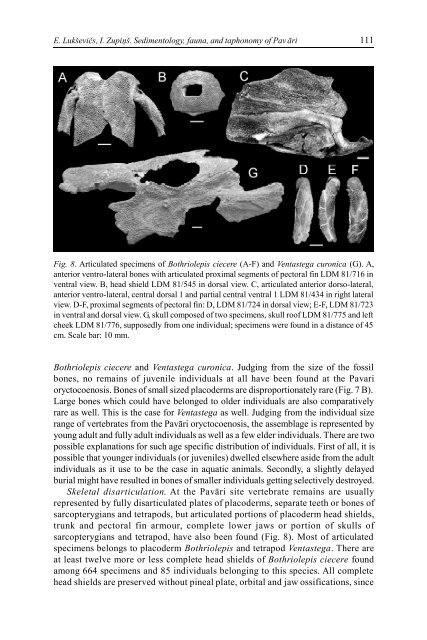Zemes un vides zinātnes Earth and Environment Sciences - Latvijas ...
Zemes un vides zinātnes Earth and Environment Sciences - Latvijas ...
Zemes un vides zinātnes Earth and Environment Sciences - Latvijas ...
You also want an ePaper? Increase the reach of your titles
YUMPU automatically turns print PDFs into web optimized ePapers that Google loves.
E. Lukševičs, I. Zupiņš. Sedimentology, fa<strong>un</strong>a, <strong>and</strong> taphonomy of Pav āri<br />
111<br />
Fig. 8. Articulated specimens of Bothriolepis ciecere (A-F) <strong>and</strong> Ventastega curonica (G). A,<br />
anterior ventro-lateral bones with articulated proximal segments of pectoral fin LDM 81/716 in<br />
ventral view. B, head shield LDM 81/545 in dorsal view. C, articulated anterior dorso-lateral,<br />
anterior ventro-lateral, central dorsal 1 <strong>and</strong> partial central ventral 1 LDM 81/434 in right lateral<br />
view. D-F, proximal segments of pectoral fin: D, LDM 81/724 in dorsal view; E-F, LDM 81/723<br />
in ventral <strong>and</strong> dorsal view. G, skull composed of two specimens, skull roof LDM 81/775 <strong>and</strong> left<br />
cheek LDM 81/776, supposedly from one individual; specimens were fo<strong>un</strong>d in a distance of 45<br />
cm. Scale bar: 10 mm.<br />
Bothriolepis ciecere <strong>and</strong> Ventastega curonica. Judging from the size of the fossil<br />
bones, no remains of juvenile individuals at all have been fo<strong>un</strong>d at the Pavari<br />
oryctocoenosis. Bones of small sized placoderms are disproportionately rare (Fig. 7 B).<br />
Large bones which could have belonged to older individuals are also comparatively<br />
rare as well. This is the case for Ventastega as well. Judging from the individual size<br />
range of vertebrates from the Pavāri oryctocoenosis, the assemblage is represented by<br />
yo<strong>un</strong>g adult <strong>and</strong> fully adult individuals as well as a few elder individuals. There are two<br />
possible explanations for such age specific distribution of individuals. First of all, it is<br />
possible that yo<strong>un</strong>ger individuals (or juveniles) dwelled elsewhere aside from the adult<br />
individuals as it use to be the case in aquatic animals. Secondly, a slightly delayed<br />
burial might have resulted in bones of smaller individuals getting selectively destroyed.<br />
Skeletal disarticulation. At the Pavāri site vertebrate remains are usually<br />
represented by fully disarticulated plates of placoderms, separate teeth or bones of<br />
sarcopterygians <strong>and</strong> tetrapods, but articulated portions of placoderm head shields,<br />
tr<strong>un</strong>k <strong>and</strong> pectoral fin armour, complete lower jaws or portion of skulls of<br />
sarcopterygians <strong>and</strong> tetrapod, have also been fo<strong>un</strong>d (Fig. 8). Most of articulated<br />
specimens belongs to placoderm Bothriolepis <strong>and</strong> tetrapod Ventastega. There are<br />
at least twelve more or less complete head shields of Bothriolepis ciecere fo<strong>un</strong>d<br />
among 664 specimens <strong>and</strong> 85 individuals belonging to this species. All complete<br />
head shields are preserved without pineal plate, orbital <strong>and</strong> jaw ossifications, since
















